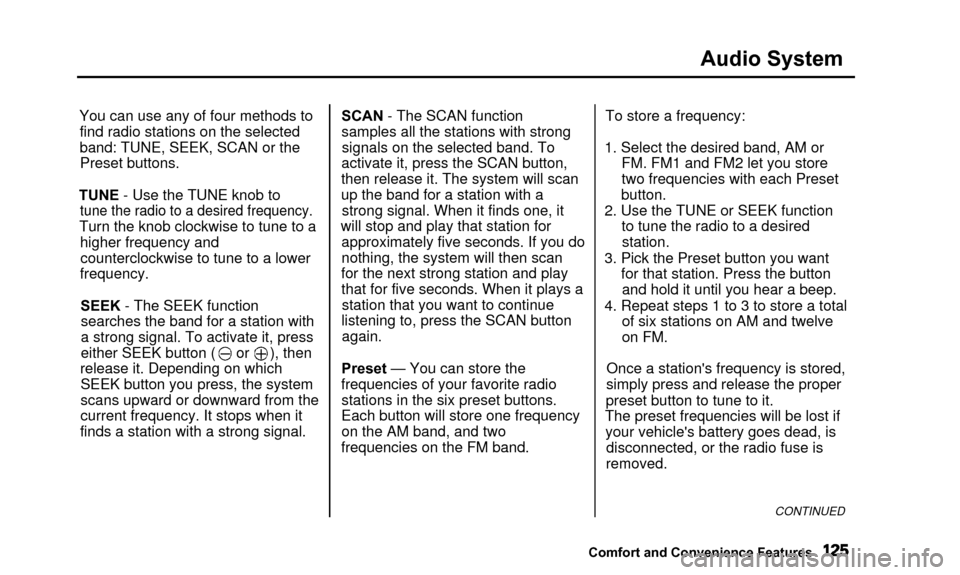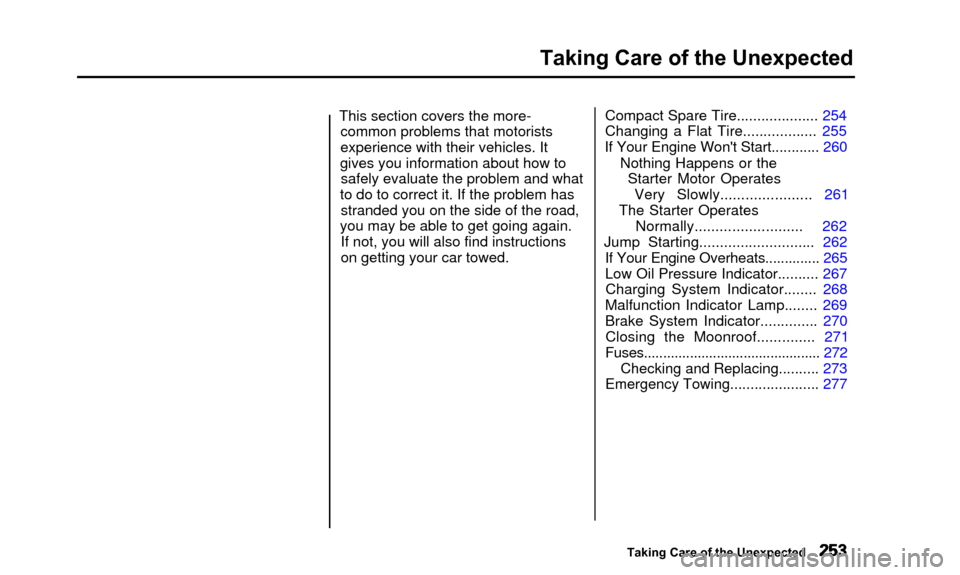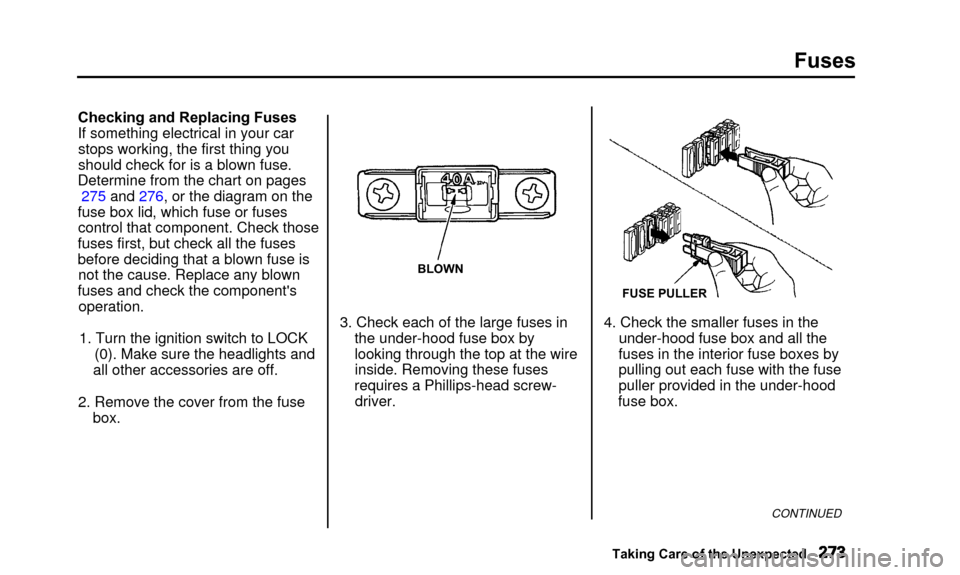fuse Acura TL 2000 3.2 Owner's Manual
[x] Cancel search | Manufacturer: ACURA, Model Year: 2000, Model line: TL, Model: Acura TL 2000Pages: 311, PDF Size: 3.05 MB
Page 128 of 311

Audio System
You can use any of four methods tofind radio stations on the selected
band: TUNE, SEEK, SCAN or thePreset buttons.
TUNE - Use the TUNE knob to
tune the radio to a desired frequency.
Turn the knob clockwise to tune to a higher frequency andcounterclockwise to tune to a lower
frequency.
SEEK - The SEEK functionsearches the band for a station with
a strong signal. To activate it, press
either SEEK button ( or ), then
release it. Depending on which SEEK button you press, the system
scans upward or downward from the
current frequency. It stops when it
finds a station with a strong signal. SCAN - The SCAN function
samples all the stations with strong
signals on the selected band. To
activate it, press the SCAN button,
then release it. The system will scan
up the band for a station with a strong signal. When it finds one, it
will stop and play that station for approximately five seconds. If you do
nothing, the system will then scan
for the next strong station and play that for five seconds. When it plays astation that you want to continue
listening to, press the SCAN button again.
Preset — You can store the
frequencies of your favorite radio stations in the six preset buttons.
Each button will store one frequency
on the AM band, and two
frequencies on the FM band. To store a frequency:
1. Select the desired band, AM or FM. FM1 and FM2 let you store
two frequencies with each Preset
button.
2. Use the TUNE or SEEK function to tune the radio to a desiredstation.
3. Pick the Preset button you want for that station. Press the buttonand hold it until you hear a beep.
4. Repeat steps 1 to 3 to store a total of six stations on AM and twelve
on FM.
Once a station's frequency is stored,
simply press and release the proper
preset button to tune to it.
The preset frequencies will be lost if your vehicle's battery goes dead, is disconnected, or the radio fuse is
removed.
CONTINUED
Comfort and Convenience Features
Page 175 of 311

The Braking System
Your Acura is equipped with discbrakes at all four wheels. A powerassist helps reduce the effort needed
on the brake pedal. The ABS helps
you retain steering control when braking very hard.
Put your foot on the brake pedal only
when you intend to brake. Resting
your foot on the pedal keeps the brakes applied lightly, causing themto build up heat. Heat build-up can
reduce how well your brakes work. Italso keeps your brake lights on all
the time, confusing drivers behind
you. Constant application of the brakes
when going down a long hill builds up heat and reduces their effective-
ness. Use the engine to assist the
brakes by downshifting to a lower
gear and taking your foot off the accelerator pedal.
Check your brakes after driving
through deep water. Apply the
brakes moderately to see if they feel normal. If not, apply them gently and
frequently until they do. Since a longer distance is needed to stop
with wet brakes, be extra cautious and alert in your driving. Brake Wear Indicators
All four brakes have audible brake wear indicators.
When the brake pads need replacing,
you will hear a distinctive metallic "screeching" sound when you apply
the brakes. If you do not have the
brake pads replaced, they will begin screeching all the time.
Your brakes may sometimes squeal or squeak when you apply them
lightly. Do not confuse this with the
brake wear indicators. They make a
very audible "screeching."
Driving
Page 256 of 311

Taking Care of the Unexpected
This section covers the more-common problems that motorists
experience with their vehicles. It
gives you information about how to safely evaluate the problem and what
to do to correct it. If the problem has stranded you on the side of the road,
you may be able to get going again. If not, you will also find instructions
on getting your car towed. Compact Spare Tire.................... 254
Changing a Flat Tire.................. 255
If Your Engine Won't Start............ 260
Nothing Happens or theStarter Motor OperatesVery Slowly...................... 261
The Starter Operates
Normally.......................... 262
Jump Starting............................ 262
If Your Engine Overheats.............. 265
Low Oil Pressure Indicator.......... 267 Charging System Indicator........ 268
Malfunction Indicator Lamp ........ 269
Brake System Indicator .............. 270
Closing the Moonroof.............. 271
Fuses.............................................. 272
Checking and Replacing.......... 273
Emergency Towing ...................... 277
Taking Care of the Unexpected
Page 264 of 311

If Your Engine Won't Start
Nothing Happens or the Starter
Motor Operates Very Slowly
When you turn the ignition switch to START (III), you do not hear the
normal noise of the engine trying tostart. You may hear a clicking sound
or series of clicks, or nothing at all.
Check these things:• Check the transmission interlock. The transmission must be in Parkor Neutral or the starter will not
operate.
• Turn the ignition switch to ON (II).
Turn on the headlights and check their brightness. If the headlightsare very dim or don't light at all,
the battery is discharged. See
Jump Starting on page 262.
• Turn the ignition switch to START (III). If the headlights do not dim,
check the condition of the fuses. If
the fuses are OK, there is proba-
bly something wrong with the electrical circuit for the ignitionswitch or starter motor. You will
need a qualified technician to determine the problem. (See
Emergency Towing on page 277.)
If the headlights dim noticeably or
go out when you try to start the engine, either the battery is dis-
charged or the connections are
corroded. Check the condition of
the battery and terminal connec- tions (see page 220). You can
then try jump starting the car froma booster battery (see page 262).
Taking Care of the Unexpected
Page 265 of 311

If Your Engine Won't Start, Jump Starting
The Starter Operates NormallyIn this case, the starter motor's
speed sounds normal, or even faster
than normal, when you turn the
ignition switch to START (III), but
the engine does not run.
• Your car has the Immobilizer System. You should use a
properly-coded master or valet key
to start the engine (see page 74).
A key that is not properly coded will cause the immobilizer systemindicator in the dash panel to blink
rapidly.
• Are you using the proper starting procedure? Refer to Starting theEngine on page 161.
• Do you have fuel? Turn the
ignition switch to ON (II) for a
minute and watch the fuel gauge.
The low fuel level warning light may not be working, so you were
not reminded to fill the tank.
• There may be an electrical problem, such as no power to the
fuel pump. Check all the fuses (see page 273).
If you find nothing wrong, you will
need a qualified technician to find
the problem. See Emergency
Towing on page 277. Jump Starting
If your car's battery has run down,
you may be able to start the engine by using a booster battery. Although
this seems like a simple procedure,
you should take several precautions.
A battery can explode if you donot follow the correct procedure,
seriously injuring anyone nearby.
Keep all sparks, open flames,
and smoking materials away
from the battery.
You cannot start your Acura by pushing or pulling it.
Taking Care of the Unexpected
Page 274 of 311

Closing the Moonroof
If the electric motor will not close
the moonroof, do the following:
1. Check the fuse for the moonroof motor (see page 276). If the fuse
is blown, replace it with one of thesame or lower rating.
2. Try closing the moonroof. If the new fuse blows immediately or the
moonroof motor still does not
operate, you can close the
moonroof manually.
3. Get the moonroof wrench out of the tool kit in the trunk.ROUND PLUG
4. Use a screwdriver or coin toremove the round plug in thecenter of the headliner.
SOCKET
5. Insert the moonroof wrench into the socket behind this plug. Turnthe wrench until the moonroof isfully closed.
6. Remove the wrench. Replace the round plug.
Taking Care of the Unexpected
Page 275 of 311

Fuses
All the electrical circuits in your carhave fuses to protect them from a short circuit or overload. These
fuses are located in three fuse boxes.INTERIOR
The interior fuse boxes are located on each side of the dashboard. To
open an interior fuse box, open the
car door. Pull the bottom of the
cover open, then take it out of itsside hinges by pulling it toward you.
UNDER-HOOD
The under-hood fuse box is located in the back of the engine compart-
ment on the passenger's side. To
open it, push the tabs as shown.
Taking Care of the Unexpected
TAB
Page 276 of 311

Fuses
Checking and Replacing Fuses
If something electrical in your car stops working, the first thing you
should check for is a blown fuse.
Determine from the chart on pages 275 and 276, or the diagram on the
fuse box lid, which fuse or fuses control that component. Check those
fuses first, but check all the fuses
before deciding that a blown fuse is not the cause. Replace any blown
fuses and check the component's operation.
1. Turn the ignition switch to LOCK (0). Make sure the headlights and
all other accessories are off.
2. Remove the cover from the fuse box.
BLOWN
3. Check each of the large fuses inthe under-hood fuse box by
looking through the top at the wireinside. Removing these fuses
requires a Phillips-head screw- driver.
FUSE PULLER
4. Check the smaller fuses in the under-hood fuse box and all the
fuses in the interior fuse boxes by
pulling out each fuse with the fuse
puller provided in the under-hood
fuse box.
CONTINUED
Taking Care of the Unexpected
Page 277 of 311

Fuses
BLOWN
5. Look for a burned wire inside thefuse. If it is burned, replace it withone of the spare fuses of the same
rating or lower. If you cannot drive the car without
fixing the problem, and you do not
have a spare fuse, take a fuse of the same rating or a lower rating from
one of the other circuits. Make sure
you can do without that circuit temporarily (such as the accessorypower socket or radio).
If you replace the blown fuse with aspare fuse that has a lower rating, it
might blow out again. This does not indicate anything wrong. Replace the
fuse with one of the correct rating as soon as you can.
Replacing a fuse with one that has a
higher rating greatly increases the
chances of damaging the electrical
system. If you do not have a replace-
ment fuse with the proper rating for the
circuit, install one with a lower rating.
6. If the replacement fuse of the same rating blows in a short time,
there is probably a serious
electrical problem in your car. Leave the blown fuse in that
circuit and have your car checked
by a qualified mechanic.
If the radio fuse is removed, the
audio system will disable itself. The next time you turn on the radio you
will see "Code" in the frequency display. Use the Preset buttons to
enter the five-digit code (see page 142).
Taking Care of the Unexpected
NOTICE
Page 278 of 311

Fuses
UNDER-HOOD FUSE BOXNo.1
2
3
4 5
6
7
8
9
10 11 Amps.
20 A-
20 A
20 A 20 A15 A -
30 A 15 A
120 A 20 A Circuits Protected
Left Headlight
Not Used
Right Headlight
ABS F/S Stop
ACG
Spare Fuse
ABS Motor
Hazard
BatteryCooling FanNo.
1213
14
15
16
17
18 19
20
21 Amps.
30 A
40 A-
40 A
20 A
40 A
40A
50 A 15 A
20 A Circuits Protected
Back Up, ACC Power Window Motor
Spare Fuse
Power Seat
TCS Heater Motor
Rear Defroster
IG1 Main
Small Light
Condenser Fan
CONTINUED
Taking Care of the Unexpected